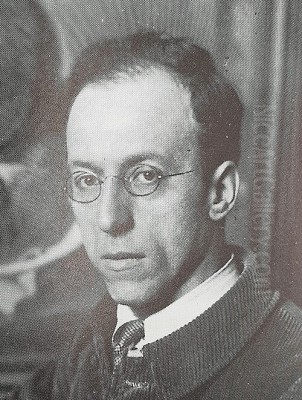
Bernard Meninsky stands as a significant, albeit sometimes overlooked, figure in twentieth-century British art. Born in Ukraine and forging his career primarily in London, Meninsky's life and work encapsulate a fascinating blend of European modernist influences and a deeply personal, often melancholic, sensibility. Renowned for his exceptional draughtsmanship, his poignant "Mother and Child" series, and his influential role as a teacher, Meninsky navigated the currents of artistic change while grappling with profound personal challenges. His journey from the Slade School of Fine Art to major museum collections reflects a dedicated artistic pursuit marked by both technical brilliance and emotional depth.
Early Life and Formative Years
Bernard Meninsky's story begins not in Britain, but in Karotopin, Ukraine, where he was born in 1891. His connection to the UK was established early, however, as his family emigrated when he was merely six weeks old, settling in the bustling port city of Liverpool. This relocation marked the beginning of his life as a British artist, albeit one whose Eastern European Jewish heritage would remain a subtle undercurrent in his identity and, some argue, his work.
Liverpool provided the initial setting for his artistic education. He enrolled at the Liverpool School of Art, taking the first crucial steps in honing the skills that would define his career. The city's vibrant cultural milieu, though perhaps less central than London's, offered a foundation upon which he would build. His talent was evident, prompting further study and a move towards the epicentre of the British art world.
The next significant stage in his development was his time at the prestigious Slade School of Fine Art in London. The Slade, under the formidable leadership of figures like Henry Tonks, emphasized rigorous drawing skills, a discipline that profoundly shaped Meninsky's artistic practice. Here, he was immersed in an environment teeming with emerging talent and radical ideas, studying alongside contemporaries who would also make their mark on British modernism.
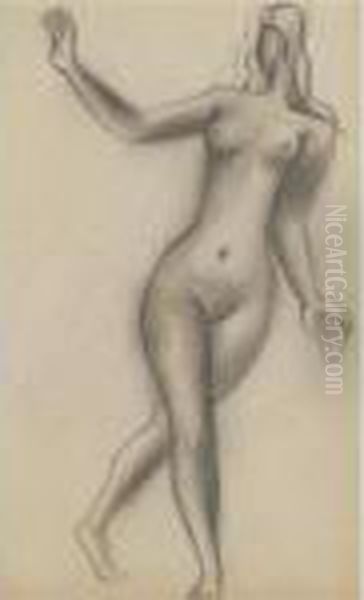
During his Slade years, Meninsky associated with a group of talented Jewish artists, often immigrants or children of immigrants, who were making waves in the London art scene. This circle included figures like David Bomberg and Jacob Kramer, sometimes referred to collectively as the "Whitechapel Boys" due to their connections to London's East End. These interactions provided both camaraderie and intellectual stimulation, placing Meninsky within a dynamic network of artists exploring new forms of expression. His training was further broadened by a period spent studying in Paris at the Académie Julian, exposing him directly to the continental avant-garde.
Emergence and Developing Style
Meninsky began to establish his reputation in the years following his formal education. A key milestone was his first solo exhibition, held in 1919. This event marked his public arrival as a distinct voice in the post-war British art scene. His work from this period began to show the synthesis of his rigorous Slade training and his engagement with European modernism.
His artistic style evolved, characterized by strong draughtsmanship, a sensitive use of colour, and often, a gentle, lyrical quality. While grounded in observational drawing, his work was far from purely academic. He absorbed and responded to the innovations transforming European art, looking particularly towards French masters. The influence of Paul Cézanne is often noted in the structural solidity of his compositions, while the expressive lines and bold colour palettes of Henri Matisse also left their mark.
Furthermore, the impact of Pablo Picasso, particularly his neoclassical phase and earlier Blue and Rose periods, can be discerned in Meninsky's figure studies. There's also a connection drawn to the more Symbolist leanings of Odilon Redon, perhaps reflected in the sometimes dreamlike or melancholic atmosphere pervading his work. Meninsky skillfully integrated these diverse influences into a personal idiom, avoiding simple imitation.
His output encompassed figure painting, landscapes, and still lifes. He worked confidently across various media, including oil paint, watercolour, and pastels, but drawing remained fundamental to his practice. His drawings, often executed with remarkable fluency and sensitivity, were highly regarded in their own right. Critics noted the delicate yet firm quality of his line and his ability to capture form and volume with economy and grace. Elements of Neo-Romanticism, a current in British art that looked towards emotional intensity and poetic interpretations of landscape and the figure, can also be identified in his work, particularly from the 1920s onwards.
Thematic Focus: Mother and Child
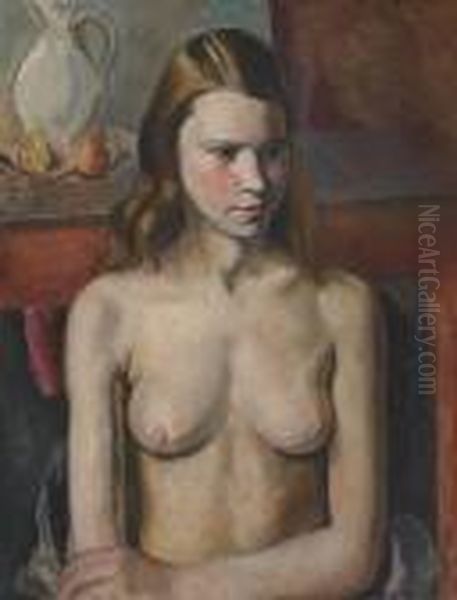
Among Meninsky's diverse subjects, one theme stands out for its persistence and emotional resonance: the "Mother and Child." This subject became a central preoccupation, resulting in a unique and extensive series of works created from around 1918 through to the mid-1940s. The initial inspiration for this focus is widely attributed to the birth of his own son, David, born during this period. This personal experience seems to have unlocked a deep vein of artistic exploration.
The "Mother and Child" works, primarily drawings but also including paintings, capture intimate moments between a mother and her infant. They move beyond mere sentimentality, exploring the profound physical and emotional bond, the tenderness, and the quiet monumentality of the relationship. Meninsky's strong draughtsmanship is evident here, defining the forms with sensitivity and often a sculptural quality reminiscent of his admiration for artists like Auguste Rodin.
In 1928, the significance of this body of work was cemented with the publication of Mother and Child: Twenty-eight Drawings by Bernard Meninsky. This volume brought his interpretations of the theme to a wider audience and solidified his reputation for handling this classic subject with a modern sensibility. The drawings showcased his ability to convey complex emotions through line and subtle shading, often imbued with a quiet dignity.
Art critics responded positively to the series. Jan Gordon, a notable critic of the time, praised these works, remarking on their ability to convey a "paternal spirit as vivid as maternity." Gordon saw in Meninsky's depictions not just an observation of motherhood, but an empathetic insight into the universal beauty and significance of the maternal bond. This series remains perhaps Meninsky's most recognized contribution, admired for its technical skill and its deeply human focus. The influence of artists like Picasso, particularly his depictions of maternity, can be seen, yet Meninsky's approach retains its own distinct tenderness and formal elegance.
Landscapes and Still Lifes: Expanding Horizons
While the "Mother and Child" series holds a prominent place in his oeuvre, Bernard Meninsky's artistic interests extended significantly beyond this single theme. He was also a dedicated painter of landscapes and still lifes, exploring these genres with the same sensitivity and technical skill that characterized his figure work. His landscapes often possess a lyrical quality, sometimes tinged with the melancholy noted elsewhere in his art.
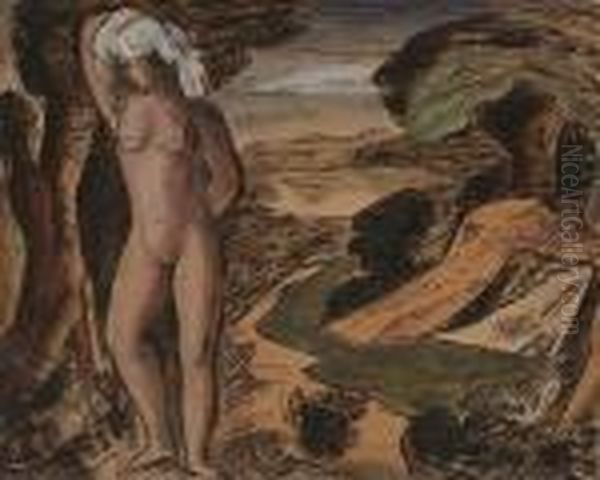
His approach to landscape painting reflected the broader currents of British art in the early to mid-twentieth century. There's often a focus on mood and atmosphere, aligning him with aspects of the Neo-Romantic movement, which saw artists like Paul Nash, Graham Sutherland, and John Piper exploring the poetic and sometimes unsettling aspects of the British landscape. Meninsky's landscapes, whether in oil or watercolour, often feature simplified forms and a subtle, nuanced colour palette.
Still life painting offered Meninsky another avenue for formal exploration. Sources suggest that still life constituted a distinct and important category within his output. These works allowed him to focus purely on composition, form, colour, and texture, arranging everyday objects into carefully considered designs. Here, the influence of Cézanne's structural approach to still life might be particularly apparent, alongside the colouristic freedom inspired by Matisse.
An interesting and perhaps less commonly known aspect of his work involved studies inspired by early Italian Renaissance masters, specifically mentioning Giotto and his contemporaries. These studies, executed in watercolour or oil, demonstrate Meninsky's deep engagement with art history and his admiration for the foundational figures of Western painting. They highlight his meticulous attention to detail and his ability to analyze and reinterpret historical compositions, showcasing the breadth of his artistic intellect and technical versatility.
A Respected Teacher
Beyond his own studio practice, Bernard Meninsky made a significant contribution to British art through his dedicated work as a teacher. He held influential teaching positions at prominent London art institutions, sharing his knowledge and rigorous approach with generations of students. His reputation as an exceptional draughtsman naturally translated into his teaching, where he emphasized the fundamental importance of drawing skills.
He served as a tutor of the mixed life class at the Westminster School of Art, a role that placed him at the heart of figure drawing instruction. Later, and perhaps most significantly, he taught drawing at the Central School of Arts and Crafts (now Central Saint Martins). His tenure at the Central School was long and influential, establishing him as a key figure in its art department. The emphasis on drawing, inherited from his own Slade training under figures like Henry Tonks, was central to his pedagogy.
His students remembered him as a demanding yet inspiring instructor. Among those who studied under him was the artist Clara Klinghoffer, herself a talented draughtswoman. Meninsky's guidance helped shape the skills and artistic outlook of many young artists navigating the London art world. His commitment to teaching demonstrated a belief in the transmission of artistic knowledge and craft.
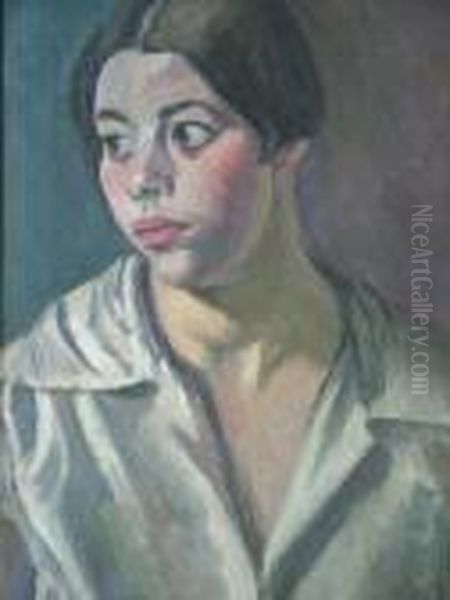
During the Second World War, like many Londoners, Meninsky relocated for safety. He moved to Oxford, where he continued his educational work, teaching art during this period of national crisis. This continuity underscores his dedication to his role as an educator even amidst difficult circumstances. His legacy as a teacher complements his achievements as a painter and draughtsman, highlighting his multifaceted impact on British art.
Connections and Context
Bernard Meninsky did not create in isolation. His career unfolded within the vibrant and complex network of the London art world, marked by interactions, influences, and collaborations. His time at the Slade placed him among key figures of his generation, fostering relationships with artists like David Bomberg and Jacob Kramer. This connection to the "Whitechapel Boys" situated him within an important group exploring modernism from a unique cultural perspective.
His work shows an awareness of, and dialogue with, other prominent artists. The influence of fellow Jewish artists like Mark Gertler, known for his intense and sculptural figure paintings, has been noted alongside that of Kramer. These connections highlight the shared concerns and stylistic explorations among this group of artists in early 20th-century London.
Meninsky also engaged with the institutional structures of the art world. His participation in the London Group, an exhibiting society founded to provide a counterpoint to the Royal Academy, placed him alongside many leading modern artists. Furthermore, his skills were recognized during the First World War when he contributed to official art schemes. He worked on commissions related to the war effort, placing him alongside artists like Bomberg and the sculptor Jacob Epstein, who were also involved in documenting or responding to the conflict through art.
His professional life also involved interactions on a more personal level. The record shows that the artist Eileen Mayo, known for her prints and design work, modelled for Meninsky. This suggests a working relationship typical of studio practice, where artists rely on models for figure studies and finished compositions. These varied connections – educational, collegial, institutional, and professional – paint a picture of an artist actively engaged with his contemporaries and the artistic currents of his time.
Later Life, Challenges, and Legacy
Despite his artistic achievements and respected teaching career, Bernard Meninsky's later life was marked by significant personal struggles. He suffered from recurring mental health problems, experiencing several severe breakdowns between 1931 and 1934. These episodes undoubtedly impacted his life and potentially his work, perhaps contributing to the melancholic undercurrent sometimes observed in his art.
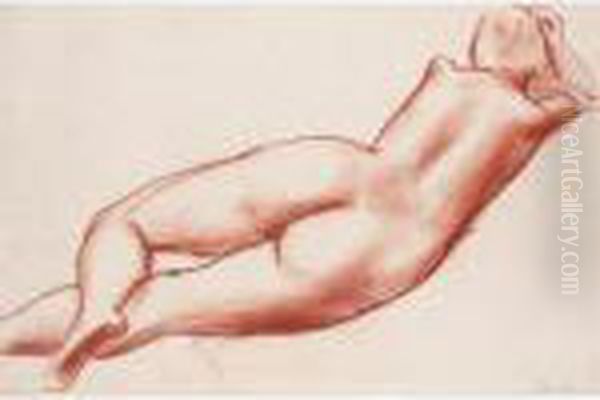
The outbreak of the Second World War brought further disruption, leading to his temporary relocation from London to Oxford, where he continued to teach. While he remained productive, the pressures of the war years combined with his pre-existing health challenges likely took a toll. His life ended tragically in 1950 when he took his own life. This sad conclusion casts a shadow over a career dedicated to the pursuit of artistic expression.
However, Meninsky's artistic legacy endured and grew after his death. While perhaps not achieving the same level of widespread fame as some of his contemporaries during his lifetime, his work received increasing recognition and appreciation posthumously. Critics and art historians came to value his exceptional draughtsmanship, the emotional depth of his "Mother and Child" series, and his unique synthesis of traditional skills and modernist influences.
His paintings and drawings found homes in major public collections, securing his place in the narrative of British art. Today, his work is held by prestigious institutions such as the Tate Gallery, the British Museum, and the Victoria and Albert Museum in London, as well as other collections in the UK and internationally, including the USA. This institutional recognition confirms his lasting importance.
Furthermore, his influence extended to subsequent generations. Artists like George Weissbort acknowledged Meninsky's impact, suggesting that both his art and his teaching left a tangible mark. He is remembered as a key figure among the talented generation of artists who emerged from the Slade before the First World War, contributing significantly to figure painting and drawing in Britain during a period of intense artistic change.
Conclusion: An Enduring Contribution
Bernard Meninsky's life journey, from Ukraine to Liverpool and finally to the heart of the London art world, was one of artistic dedication amidst personal adversity. He emerged as a distinctive voice in 20th-century British art, celebrated for his superb drawing skills, his sensitive handling of colour and form, and his profound exploration of the "Mother and Child" theme. His ability to absorb influences from masters like Cézanne, Matisse, and Picasso, while retaining a personal, often introspective style, marks him as a thoughtful and skilled modern artist.
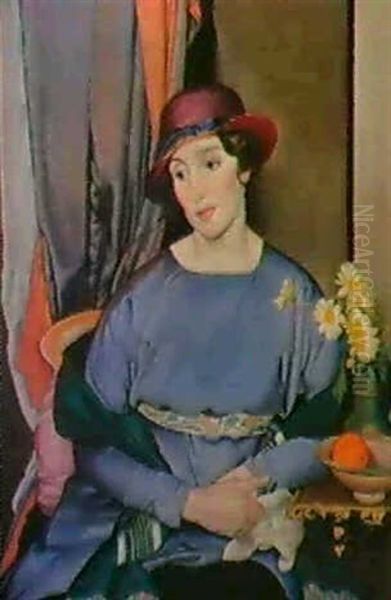
His contribution extends beyond his own canvases and drawings. As an influential teacher at institutions like the Central School of Arts and Crafts, he imparted rigorous standards of draughtsmanship and artistic integrity to his students, shaping the future direction of British art in subtle but important ways. His connections with contemporaries like David Bomberg, Jacob Kramer, and Mark Gertler place him firmly within the dynamic narrative of London modernism.
Though his career was tragically cut short and overshadowed by personal struggles, Bernard Meninsky's work continues to resonate. Held in major museum collections and appreciated for its technical mastery and emotional honesty, his art offers a compelling window into the concerns and aesthetics of his time. He remains a testament to the enduring power of figurative art to convey deep human feeling, securing his position as a significant and respected figure in the history of British painting and drawing.